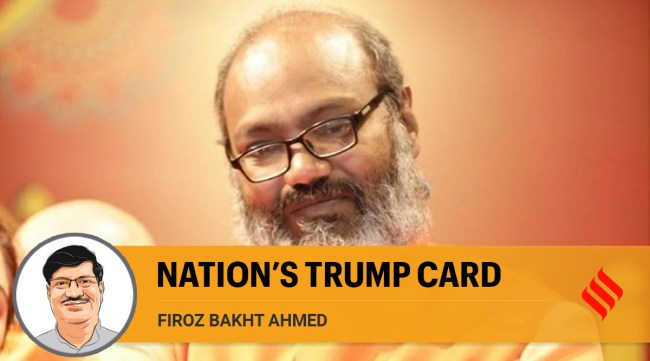Opinion The spirit of assimilation is India’s trump card
Firoz Bakht Ahmed writes: It’s unfortunate that every thinking Indian needs to today define their position on issues like mosques, temples, hijab and azaan while serious economic, educational, unemployment and social problems cry for attention.
 Yati Narsinghanand. (Twitter/NarsinghVani)
Yati Narsinghanand. (Twitter/NarsinghVani) There is Maulana Tauqeer Raza Khan, the Ittehad-e-Millat Council party chief and cleric, and there is Yati Narsinghanand Saraswati, the priest of the Dasna Devi temple in Ghaziabad, Uttar Pradesh. Unfortunately, both have loudspeakers with decibel levels that no one wants to control. Raza abuses the prime minister, blatantly calls for jihad and aims to provoke Muslims against Hindus. Narsinghanand, slapped on the wrist with a few FIRs, calls for genocide.
How much of a resonance they have in their communities beyond social media or WhatsApp is not known but one thing is clear: A majority in both the communities are invested in the future of a safe and prosperous India. People of both communities want their children to study hard and be treated fairly in the competitive world of education and employment. One can hope that the hate-filled words don’t carry far.
RSS chief Mohan Bhagwat was absolutely right when he said that you cannot imagine India without the contribution of Muslims. And, “the day it is said that Muslims are unwanted here, the concept of Hindutva will cease to be,” he had said. It’s unfortunate that these remarks don’t reach the rabble-rousers who peddle hate.
It’s also unfortunate that every thinking Indian, with a minimum sense of civic responsibility, needs to today define her position on issues like mosques, temples, hijab and azaan while serious economic, educational, unemployment and social problems cry for attention. But let’s use this occasion as an opportunity to create a new social compact in which each one of us, whichever God we pray to, contributes to lowering tension and blurring the communal divide.
For, this is a country where the great poet Iqbal once said about Lord Ram:“Hai Ram ke wajood pe Hindostan ko naaz/Ahle nazr samajhte hain us ko Imam-e-Hind!” (The people of India feel proud to find Ram among them/ People of vision take him as a great spiritual leader of India). Iqbal’s words are not frozen in time but have to be part of a continuous process of assimilation. For this to happen, there has to be reform and rethinking on both sides.
Muslims must start thinking about the ideology of negating the BJP and vowing to vote for anyone who is “capable of defeating the BJP.”
This has done a world of harm to them because the parties wanting to “defeat the BJP” seem to be caught in a time warp — in a world in which dynasties are privileged. There was a time, during the six decades of Congress rule, when it was held — and the Congress is guilty of perpetuating this myth — that to come to power at the Centre, you needed the Muslim vote. That myth was shattered in 2014 and in virtually every election since then.
Muslims know that these parties have failed to address their social, educational and security problems. Yet, these parties banked on their vote. No wonder, the refrain of all these parties — the Congress, Samajwadi Party, Trinamool Congress, Bahujan Samaj Party, and the AIMIM — is that the RSS and BJP are out to marginalise the Muslims. Why don’t these parties have Muslims in their top echelons?
The controversy over the hijab in a few districts in Karnataka was sought to be made into a national issue when it found no resonance in any other state. The fears of India becoming a Hindu theocratic state are also overblown as secular and peace-loving Hindus vastly outnumber the bigoted, rabid fringe. When a young Hindu man in Hyderabad, B Nagaraju, was murdered in full public view by the Muslim brother of his wife Ashreen Sultana, his only crime being that he and his wife were in love, very few in the community stood up and spoke against it. Even the usual suspects who issue pamphlets were silent.
Before the dismemberment of the Subcontinent, the Muslim peasant in Bengal participated as joyously in the village Durga Puja as his Hindu neighbour. In Bangladesh, Hindus celebrated Id. If entire Muslim villages in Malaysia can watch the Ramayana being performed on stage, there is no reason why they cannot do the same in India or include Hindus in their tazia processions and Karbala enactments.
Meena Kumari, Nargis, Waheeda Rehman and Mumtaz played the role of the devoted Hindu wife with sindoor on their foreheads. What about bhajans sung in Mohammed Rafi’s sonorous voice? Should we ban these recordings? Should we stop seeing films starring Dilip Kumar or Aamir Khan or Salman Khan? After namaz when Muslims stepped out of mosques, in almost all walled city neighbourhoods across India, one could observe Hindu men and women standing with their sick children to be blessed. A maulvi sahib used to wake up a panditji to ring the temple bells in the morning. Sir Syed Ahmad Khan once paid a fitting tribute to India’s composite culture by describing the country as a beautiful bride with two bewitching eyes — Hindus and Muslims.
Sufi saints like Sheikh Muinuddin Chishti, Hazrat Nizamuddin Auliya, Khwaja Qutubuddin Bakhtiyar Kaki and other pirs like Haji Malang in Maharashtra are revered by all Indians irrespective of their faith. The spirit of assimilation is India’s trump card; it can make the country a beacon of hope for the world. Urdu poet, Afzal Manglori has laid out the goal aptly: “Koi mushkil nahin hei Hindu ya Musalmaan hona/ Haan badi baat hai is daur mein insaan hona (It’s no feat to be a Hindu or Muslim/What matters today is to be a good human).
This column first appeared in the print edition on May 19, 2022 under the title ‘Nation’s trump card’. The author is former Vice-Chancellor, Maulana Azad National Urdu University






